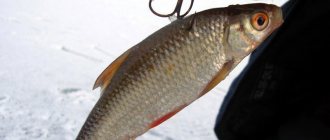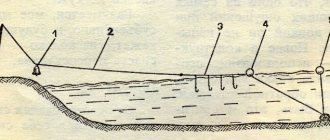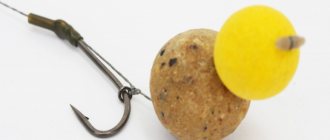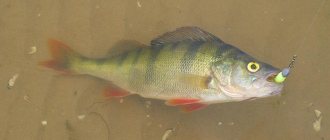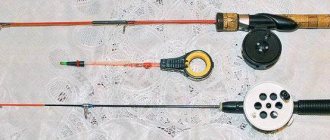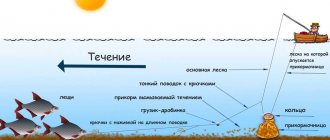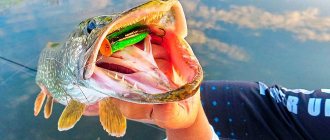Setting up a fishing lane
A net with an elastic band is designed on the principle of a donkey with a rubber shock absorber, only here, instead of a dozen hooks, there is a net.
It is structured as follows:
- a pole for securing the gear on the shore (a regular stick can be used instead);
- fishing line connecting the mesh and the pole;
- network (up to 7 m);
- the top edge is equipped with a floating cord;
- the lower edge is threaded with weights (weight cord);
- cargo (stone or brick);
- rubber thread (connects the upper edge of the mesh and the load).
Sometimes a signal bell is tied to the fishing line, notifying the fisherman about a bite. The use of a bell is justified when it comes to catching large fish.
If a large perch gets caught in the net, it will roll up its web with its power and no one else will get caught there. With the use of a bell, a fisherman in such a situation will be able to remove the catch and cast the tackle again.
Throwing a net goes like this:
- A fisherman throws a load into the river.
- The load pulls along a net with a float and cargo line.
- The fishing line and shock absorber, fastened with carabiners, are separated and attached to loops located at the ends of the float cord.
- The weight of the carabiners is offset by two foam floats, which, in addition, help the net keep its rectangular shape.
The height of the device reaches one and a half meters, length – 7 m.
Fishing net with elastic band
A fishing net or fishing line is a favorite tackle of many experienced fishermen; it is a mixture of a slingshot and a net, used both for catching large fish (perch, pike, etc.) and for catching live bait (bait for predators). It is more correct to call it a “mesh with a rubber shock absorber” or a “screen with a rubber shock absorber”, depending on the size.
A group of fishermen revealed the name of the secret bait during interrogation.
Category: regional news.
- Setting up a fishing lane
- Features of operation
- Application area
Setting up a fishing lane
A net with an elastic band is designed on the principle of a donkey with a rubber shock absorber, only here, instead of a dozen hooks, there is a net.
Features of operation
Fishing with a fishing line requires knowledge of the body of water and its inhabitants.
Fishing with such nets using complementary foods, for example, a mixture will be especially successful:
- silt;
- sand;
- clay;
- pearl barley;
- cake;
- garlic, etc.
Then, even in the absence of a float bite, you will get several small trophies.
Throw it in after clearing the bottom.
It is necessary to correctly calculate the weight of the load so as not to accidentally tear the rubber when removing the catch.
Application area
A fishing net with a rubber shock absorber is used in small bodies of water, mainly in urban ponds, where there are quite a lot of fishermen in a small volume of water space:
- This compact, easy-to-use and portable gear is perfect for relaxing after work for two or three hours.
- Its use is especially important during the heyday of water lilies, when it is impossible to set up large nets, but casting fishing lanes makes it possible to increase the catch of pike, which hide in water lilies from the heat.
The main rule is that the reservoir should be deep and, if possible, with a clean bottom.
Fishing with an elastic band - features of making tackle, fishing techniques and tactics (85 photos)
For hundreds of years, this original Russian invention has been helping people get good catches. Specimens, sometimes reaching 20 kg, cannot but delight the fisherman. Today we will talk about elastic. A bottom fishing rod with a rubber shock absorber is its official name. This fairly simple fishing method works incredibly clearly and smoothly.

Fishing with a rubber band is an amazing method that can cover all types of rivers and reservoirs that are of interest to each individual fisherman.

Brief contents of the review:
What does the track tackle consist of?
There are no standards for network tracks, however, the most common composition you can see is:
- Spinning reel
- Carbon fiber spinning rod
- Network
Fishing tackle-track can have different interpretations. For example, instead of a spinning reel, a multiplier reel is quite suitable, and a high-quality “braid” can be replaced by 0.3 mm monofilament.
Pros and cons of using braided cord and monofilament. You should start with the fact that they differ in size: if the monofilament has 0.3 mm, then the section of the braided cord varies from 0.17 mm to 0.2 mm.
In general, the main difference lies in sensitivity: the bell when using “braid” rings even when it slightly touches the bottom, while monofilament is less sensitive to this fact. It all depends on what kind of fish you came to the pond for.
It is also worth noting that monofilament is less tangled than braided line - it can provide a greater catch. Another fishing tackle is made using a similar principle - a track with a rubber shock absorber, therefore the principle of fishing where a mesh track is used is similar. One of the differences is that donks with a rubber shock absorber use five to ten hooks instead of nets.
"Track"
This recently appeared tackle has nothing to do with fishing with spoons from a boat floating under oars, sail or motor - a coincidence of names, nothing more. It would be more correct to call it a “network with a rubber shock absorber”; small “paths” – “screens with rubber shock absorbers”.
The general diagram of the “track” is shown in Fig. 12, and fishing with it is not much different from fishing with a donkey with a shock absorber: the fisherman throws a heavy load with a rubber thread tied to it into the reservoir, and then, as it contracts, inserts a small fixed net into the reservoir, planted on the cargo and floating cords.
The net itself usually does not participate in casting: the fishing line and elastic band are connected using two metal carabiners, and after casting, the carbines are disconnected and attached to loops made at the ends of the floating cord. The weight of the carabiners is compensated by two large foam floats, which also help ensure that the residual tension of the elastic does not prevent the net from standing in the water in a regular rectangle.
The mesh pitch depends on the size of the expected prey. The height of the net rarely exceeds 1.5 m, and the length (when casting from the shore) is 7 m.
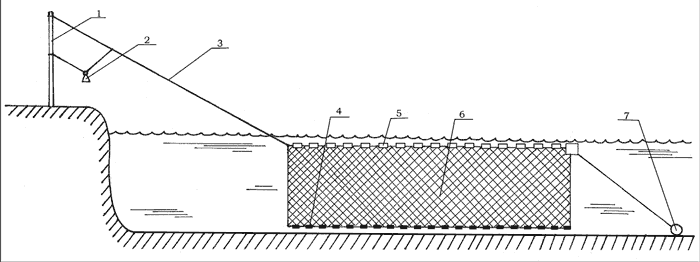
Rice. 12. Fishing on the “track”: 1 – pole; 2 – signaling bell; 3 – fishing line (diameter 1–1.2 mm, length up to 30 m); 4 – load cord; 5 – floating cord; 6 – net (up to 7 m in landing); 7 – weight (weight is determined by the thickness of the rubber shock absorber)
There is another, simplified “track” design. In it, both the cargo and floating cords are replaced with thick nylon thread. The net is stretched into a rectangular shape horizontally by the tension of the elastic band and fishing line, and vertically by thin, strong slats tied on the sides in the manner of nags on a seine (the lower ends of the slats are weighted with lead weights, providing slight negative buoyancy).
Tackle assembled according to the second option provides significantly less resistance when the shock absorber pulls it into the reservoir, which allows the use of longer nets - up to 15–20 m. However, it can only be used in standing reservoirs; even a weak current bends the slats and lays them on bottom. Therefore, such a “path” is most often used for pond fishing for crucian carp.
Naturally, the small size of the net allows the “travelers” to succeed only with excellent knowledge of the reservoir and the habits of the fish inhabiting it. But you can also “value” a full-weight thirty-meter net, in this case both the fishing line and the rubber are made 3-4 times longer, and the load is brought into the reservoir from a boat, less often (in warm weather) by swimming. In such cases, rubber is used that is more powerful (for example, a rubber band with a rectangular cross-section of 4x1.5 mm works well).
Sometimes (in narrow and shallow water bodies, as well as in bays and creeks with clean shores), the load is not used, but a rubber shock absorber is tied to a wire ring placed on a peg driven into the opposite shore. This method allows you to avoid tearing the rubber when pulling the load out of the pond. In other cases, between the rubber and the load (most often a stone picked up on the shore), it is useful to tie a short piece of fishing line, the tensile strength of which is 1.5–2 times less than that of a rubber shock absorber. But even this precaution does not always save the shock absorber from rupture.
A bell serves as a signal that a fish is entangled in the net; There is no point in leaving “paths” for “samolov”, since the only pike that comes across will very quickly wrap a small net around itself, and the rest of the fish will calmly swim past.
The “path” is very convenient on small reservoirs located near large cities and experiencing strong pressure from urban fishermen.
Network Installation Tips
Depending on where exactly you place the net, your catch depends. For example, if the bottom is not viscous, then you can put a path near the shore - for this you don’t even need to swim somewhere. This is a very good way to set up a net during the active hunting season for predators.
Using boats gives you more room to maneuver. A good catch will be ensured by a net placed in places where the depth of the bottom changes sharply - a kind of cliff, only under water. In such places, pike perch and perch are often caught in the net.
After each fishing trip, the net, like any tool, must be carefully inspected for holes, timely repairs made as necessary, and cleaned of algae and other debris. The positive aspects of elastic compared to other bottom fishing rods:
- In case you are catching a large fish, it is unlikely that the line will break, since the elastic band is shock-absorbing;
- High sensitivity;
- You can catch any fish with this type of bottom fishing rod;
- The process of re-planting bait is greatly facilitated due to the fact that the hooks do not lie on the ground, but hang on a fishing line;
- The sinker does not cling to any obstacles such as stones and grass, which makes landing fish more convenient.
What kind of fish is suitable for line fishing?
In principle, in this way you can catch any fish, including large ones, if you choose the right bait that will be interesting to the species you came for. However, this does not always mean that only pike or perch will be caught in the net.
Line fishing is also suitable for those who do not want to sit tensely with a fishing rod - this type of fishing will not force you to sit for hours in one place in a tense position. You will be able to “open the season” by simultaneously preparing barbecue. The most favorable periods for fishing are from the second half of July until the end of autumn, with the peak being in August-September.
Fisherman, remember!
Considering that summer is approaching, but the winds are still blowing through reservoirs, it is worth remembering the water safety rules. The boat should always have a life jacket or any other device that can help you stay above the water in case of danger.
It would also be a good idea to leave a first aid bag in the boat, the contents of which you will select individually. Among the essentials there should be ammonia, alcohol and cotton wool.
Catching pike on the path

Pike spawns during the spring opening of rivers. Soon after it, a quiet prey hunt begins, which can continue until late autumn. Many fans believe that the best way to catch pike is on a track. The fish are caught on the track from a boat moving across a pond. The boat should be light and maneuverable. One person sits on the oars, the second treasures. But you can do it alone with a certain skill.
Fishing places
When planning a hunting strategy, the angler will need to know the places where there is a high probability that a predator will show interest in the movement of the bait. Pike loves quiet and shallow backwaters, located on the borders of thickets and free areas of water. Pike perch are caught on the currents by guiding the boat over underwater holes and ditches, trying to move with each subsequent pass closer to the ledges that turn into shallower water areas. Catfish are searched for at the boundaries of calm water and deep pools, as well as at the junctions of clear water zones with snags and dead wood. The perch stays near the cliffs of the banks, where the currents slow down and turn into a slow reverse thrust. The fishing spots for the asp are determined by its fight, trying to guide the boat exactly along the trajectories of its hunt, and these are rifts and exits to the sandbank with a calmer and even current.
Methods of fishing on the track
The track is a special device for catching predatory fish, which has several varieties.
- Catching by hand. The fisherman holds a loose line in his hand, and some even manage to hold it in their teeth, which is convenient when fishing alone. You can also press the cord with your foot or paddle.
- Fishing with a special reel.
- Fishing with a rod equipped with a reel. This is the best and more convenient equipment for the track, allowing you to maneuver a moving spoon and bring out fish stuck at depth.
Fishing methods
You can catch fish on the track using several fishing methods. To do this, the angler can use different techniques for presenting the bait. You can cast the equipment into the fishing start zone by casting from a boat a couple of tens of meters and start moving with a fixed bait, or you can drop the required amount of line to increase the distance and only then continue moving.
The second method is to lower the bait into the water directly behind the stern of the boat and move it to the required distance, controlling the line coming off and then fixing it when the required footage is reached. And also an important factor when feeding bait is the current. If in standing and weakly flowing waters this parameter does not affect the movement of the bait, then in strong currents the quality of the retrieve will depend on the direction the boat is moving with or against the current.
Important! Movement against the current will stabilize the game of a wobbler or spinner. Moving with the current will require selecting the speed of the boat to control the bait with the cord of the tackle, which must be in constant tension, which is achieved by moving the boat slightly ahead of the speed of the current.
Conventional rafting with the current does not guarantee the effectiveness of bait play and in most cases does not bring success.
Equipment for fishing on the track
Any rod equipped with guide rings is suitable for making a track: a reed rod with a thickened butt, 1 to 1.5 m long; rods for spinning fishing; from bamboo, hazel, young birch and other elastic wood. Usually the length of such a rod for the track is arbitrary, most often about 3 m. But longer ones can be used for fishing in thickets of bushes or reeds, when it is necessary to maneuver a moving spoon, circling it from one side or the other between the branches and shifting the rod from hand to hand .
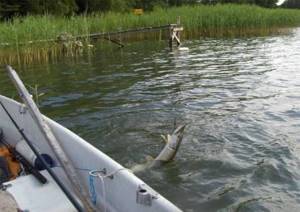
Any reel for the track is suitable, has good strength and can accommodate 100 m of cord.
For equipping a track on a fishing rod, “Saturn” (0.35-0.5 m), also “Kapron” and cord No. 1 are well suited, and for a track for fishing “by hand” or with a reel - cord No. 2. The length of the cord is approx. 100 meters.
A leash for this purpose is required with two carabiners at the ends, solid, steel, 1 to 1.5 meters long.
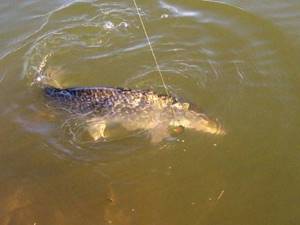
To avoid twisting of the cord when the spinner rotates while moving, a weight is attached between the cord and the leash, the weight of which is determined practically, usually from 20 to 45 g. When fishing with a heavy spoon, the weight is replaced with an anti-kinker.
When catching pike on the track, all kinds of spoons are used as bait. In spring - larger, in summer smaller. Larger again in the fall.
The color of the spoon and its shape is determined experimentally and depends on the conditions in which the pike lives. You can also value live bait. It is better to take spinners from thin metal; they are more mobile and “playful” when retrieved than heavy ones. Heavy lures can also be used under certain fishing conditions.
How to make
You can make an elastic band with your own hands from simple and inexpensive materials that can be easily purchased at any fishing or hardware store.
This gear has the following device:
- main line;
- rubber shock absorber;
- leashes with hooks;
- sinker tied on a nylon cord (allowed without it);
- reel or reel for storing and ;
- (bell).
So, monofilament with a diameter of 0.40–0.50 mm is used as the main fishing line. When catching small fish, such as crucian carp or perch, you can take a monofilament line 0.20–0.25 mm in diameter. The length of the working cord depends on the fishing range, but it is advisable to have several tens of meters in reserve.
Leashes are also knitted from monofilament. Only their diameter should be slightly smaller than the main line. This is done so that in the event of a possible snag, only this element breaks off, and the tackle itself survives.
The length of the leashes varies from 10 cm to a meter. It all depends on the mood of the fish, the bait used and the actual fishing conditions (spit or hole, with or without current). The hook is tied to the intended bait.
It is advisable to have equipment with different characteristics in stock, which will allow you to quickly adapt.
The elastic band is selected to have a round cross-section. The length of the shock absorber ranges from 5 to 20 meters, depending on the fishing distance. It usually stretches four to five times, which should be taken into account when choosing its length.
For loading, either a brick or stone, or a lead sinker is used. The weight of the sinker is determined by the presence of current, the hardness of the bottom and the fishing distance. A meter of thick fishing line or nylon cord is tied to the load, which is then connected to an elastic band.
A bell is usually used as a bite alarm. In “field” conditions, you can use an ordinary twig. If the donka is stationary for several days, and the fisherman comes to check it only periodically, then it would be correct to do without this element, so as not to attract unnecessary attention to the unattended gear.
To wind the tackle, you can use homemade wooden or foam reels, or you can buy factory ones made of plastic. Less commonly used is an inertial reel attached to a short fishing rod.
When fishing at long distances with a large load, when it is impossible to cast the tackle from the shore and you have to use a boat, it is also necessary to equip the elastic with a foam plastic float. It is tied to a load with a rope or thick fishing line. Such a buoy shows the location of the sinker so that you don’t have to look for it at the end of the fishing trip.
How to tie an elastic band with fishing line
There are several ways to connect the main line with an elastic band:
- tie the fishing line and shock absorber to the swivel;
- using fishing knots;
- using a rubber tube.
The last method is very original and is somewhat similar to a “loop-to-loop” connection:
- A silicone tube up to five cm long is placed on the end of the elastic band, and a loop is tied so that the tube is inside the loop.
- Then the main fishing line is threaded into the tube and a loop is also knitted.
That's it, the connection is ready. It is very simple, reliable and can withstand loads of up to a kilogram.
Which cargo is better
Of course, it is advisable to have a lead sinker. Its shape should allow the equipment to be securely fixed at one point. Most often, ring-shaped weights with notches along the perimeter are used. This type is great for currents and hard bottoms.
Other models can be used in calm waters. The main thing is that when removing the gear from the water, the elastic band cannot move this anchor from its place. If lead is not at hand, then ordinary brick or stone will do.
About leashes
When catching peaceful fish, leashes are made from monofilament. Their length is selected based on the mood of the fish and the presence of current. In passive fishing they are usually longer than in active fishing. They are made especially long when catching pelagic fish: sabrefish, blue bream and other species.
It is advisable to catch predatory fish with metal leashes. This way you can avoid cutting the bait. To do this, use thick monofilament fishing line, folded in half, or fluorocarbon.
Track fishing technique
The technique of catching pike on the track is quite simple, but it requires practical knowledge and skills in using tackle and operating a boat.
Fishing alone starts from a shallow, clean place, lowering the spoon to the bottom. They secure the rod in the boat or clamp it between their knees, gradually releasing the cord, and quietly move away from the shore. Having driven to the required distance, take the rod in your hand, lifting the spoon from the bottom with a slight sharp movement, and direct the boat upstream, adhering to the chosen course.
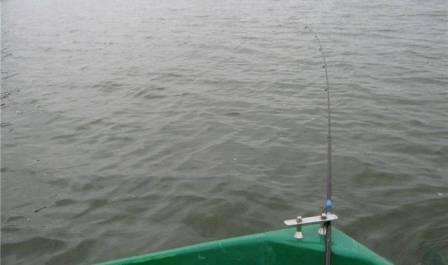
If you are going to use the spinning method, you can start right away, not from the shore. You need to row quietly, without making unnecessary splashes and noise, while the boat should move evenly, without jerking, then the spoon will remain at the same depth all the time, without rising or sinking unnecessarily. Based on fishing conditions, the length of the cord is adjustable from 20 to 80 meters. The shallower the location, the longer the length of the cord. If the fishing depth is 1.5-2 m, then the optimal cord length is from 40 to 60 m.
The spoon should not go along the bottom, but also not rise high. About half a meter from the bottom will be enough if it is relatively flat and clean. If the bottom of the reservoir is uneven, then it is better to cast the spoon at a distance of 1 meter from it or at “half water”. When the boat moves slowly, the spinner dives deeper, and when the boat moves faster, it rises higher. Therefore, in a fast current you need to row more slowly, and in a slow current - a little faster. The required speed is determined on site in a practical way.

You can check whether the spoon has caught water grass or debris from the bottom by listening to the movements of the cord. If it vibrates evenly in your hand, it means the spoon is free and moving correctly. If it is clogged, you will not feel vibrations.
To clear the lure of debris clinging to it, jerk the cord sharply several times. But sometimes this technique does not help, then you need to pull out the track, clean it of debris and unravel it again.
Technique for fishing with a rubber band and casting from the shore
Let's look at all the tricks of fishing with an elastic band, starting with the obvious advantages of the method:
- The load is cast once, and there is no need for repeated casts to scare away the fish.
- The elastic band does a good job of absorbing the jerks of strong fish.
- The process of changing bait is simplified - it is done by weight.
- Baited hooks always return to the same place.
- The donka with an elastic band has excellent sensitivity to bites.
There is only one drawback - without certain casting skills, you can seriously tangle the line. However, if everything worked out, further fishing will not be difficult.
Carefully study the video, it clearly shows how to cast and not tangle the line.
How to throw (start) a donk with an elastic band
- Before casting, all the gear, from the elastic to the reel, is unwound and laid out in a spiral on the shore, so that there is no interference from stones or vegetation.
- A weight is securely tied to the end of the elastic band.
- The reel with a supply of fishing line is attached to a peg (you can hold it in your free hand).
- Standing on the side of the laid out fishing line, the fisherman casts the load to the desired place. If this is a river, you should take into account the drift of the load by the current before it sinks to the bottom.
- A pause of 5-10 minutes is taken so that the load settles securely to the bottom.
- A section of fishing line is pulled ashore where the leashes will be attached. Above it, a loop is made on the fishing line, which clings to a specially installed slingshot, so that there is free access to all leashes.
- The leashes are hung, the bait is attached, and the line is carefully released into the water.
- Excess fishing line is wound on a reel, which is attached to a pre-driven peg.
- All that remains is to attach a guard (a bell or other bite alarm) and wait.
- If casting is carried out from a boat, the current of the river must also be taken into account. Sometimes it makes sense to lay out the tackle along the shore, against the flow of the water, in order to start the boat ride from there, and in the right place lower the load with the buoy to the bottom.
- If you plan to fish at shallow depths in the summer, you can wade the load.
These are the general rules for throwing a rubber band. But the process of catching a particular fish can vary significantly.
Pike perch on a spinning rod - a guide to choosing tackle, bait and a story about the technique of catching a deep-sea fanged hunter.
The best fishing knot - it does not come undone, does not reduce the strength of the connection and does not move, learn how to knit a figure eight correctly.
Catching sabrefish with an elastic band
Chekhon is the most popular fish that you can catch without a rubber band.
The rubber band seems to be specially created for catching sabrefish - it is this tackle that allows you to get the richest catch. The best time to catch this fish is from May to September. She loves shallow rocky or sandy sections of the river, usually walking in schools, closer to the surface of the water.
Lure
- A mixture of breadcrumbs and millet porridge (1 to 1) is good for baiting sabrefish. The finished cooked mixture is placed in a feeder made of fine mesh. It is installed at a distance of 5-6 meters from the location of the hooks upstream. It is tied to a buoy at the surface of the water and secured at the bottom with a weight.
- You can also use a plastic bottle with frequently made holes, and even uncooked millet groats or breadcrumbs as bait.
- The bait is gradually washed away by the water and goes downstream, thereby attracting shoals of sabrefish to the fishing spot.
Bait and fishing technique
- The best option for sabrefish is maggots, 4-5 pieces per hook. Closer to autumn you can use fry.
- The bait should be located closer to the surface of the water, so be sure to install a float between the elastic band and the area with the leashes. It can be a foam ball with a diameter of about 5 cm, or a hollow factory one with good buoyancy.
- The saberfish reacts more actively to moving bait, so it is necessary to “play” with it. The line is held in the hand, a sharp jerk is made, then smoothly released into the water until it stops. Pause for about 3-4 seconds, and the cycle repeats. Sometimes you can add variety to the game by changing the frequency and duration of jerks.
How to catch crucian carp with an elastic band
Crucian carp, especially small ones, go very well on elastic bands
- This is perhaps the most uncomplicated type of fishing. Crucian carp loves everything, and you can use bread, hominy, worms, maggots, and bloodworms as bait.
- The most important thing is to feed the fishing spot well, and in a well-chosen area (and crucian carp can be found everywhere) you will not be left without a catch. This fish loves fragrant baits, so the best option would be to use pureed sunflower, flax or hemp seeds in their composition.
- To make fishing more effective, you can put feeder spring feeders filled with bait on the fishing line between the leashes. The rubber band is released into place and shaken vigorously so that the nutritional mixture comes out of the feeders. This procedure is repeated 2-3 times. As a result, a well-fed fishing zone is formed exactly in the place where the crucian carp will be waiting for bait on the hooks.

